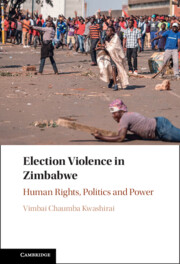Book contents
- Election Violence in Zimbabwe
- Election Violence in Zimbabwe
- Copyright page
- Dedication
- Contents
- Figures
- Tables
- Preface
- Acknowledgements
- Abbreviations
- Introduction
- 1 Violence, a Colonial Curse
- 2 Zanu PF and PF Zapu Violence
- 3 The New Enemy in the 1990 General Elections Was Zum
- 4 Zanu PF on Zanu PF Violence in 1995
- 5 What Presidential Election in 1996?
- 6 The Movement for Democratic Change Was Number One Enemy in 2000
- 7 Presidential Election in 2002
- 8 What General Elections in 2005?
- 9 Disharmony in the 2008 Harmonised Elections
- 10 Violence in the 2013 Elections
- Conclusions
- Recommendations
- Select References
- Index
4 - Zanu PF on Zanu PF Violence in 1995
Published online by Cambridge University Press: 23 February 2023
- Election Violence in Zimbabwe
- Election Violence in Zimbabwe
- Copyright page
- Dedication
- Contents
- Figures
- Tables
- Preface
- Acknowledgements
- Abbreviations
- Introduction
- 1 Violence, a Colonial Curse
- 2 Zanu PF and PF Zapu Violence
- 3 The New Enemy in the 1990 General Elections Was Zum
- 4 Zanu PF on Zanu PF Violence in 1995
- 5 What Presidential Election in 1996?
- 6 The Movement for Democratic Change Was Number One Enemy in 2000
- 7 Presidential Election in 2002
- 8 What General Elections in 2005?
- 9 Disharmony in the 2008 Harmonised Elections
- 10 Violence in the 2013 Elections
- Conclusions
- Recommendations
- Select References
- Index
Summary
Zimbabwe’s 1995 general election was conducted in the context of a ferocious debate on the country’s controversial constitution and a disastrous economic structural adjustment programme (ESAP). Zanu PF had already won a parliamentary majority well before votes were cast. It had the advantage of having thirty presidentially appointed MPs and fifty-five of its sitting MPs stood unopposed. The national voters’ register remained in a complete shambles. A weak and divided political opposition seemed to be a permanent feature in the country. Zanu PF neither accepted nor tolerated political opponents, believing it had entitlement to be in power forever. Zanu PF participation in the anti-colonial liberation war was a major justification for supressing political opposition parties. Zanu PF’s mindset was, by hook or crook, de jure or de facto bent on achieving a one-party state. The hallmarks of the 1995 elections were the controversial constitution, weak opposition, Zanu PF’s manipulation, and bending and breaking of election rules, including its lack of political will to develop a viable voters’ roll. The economic structural adjustment programme had already ruined peoples’ livelihoods by the mid-1990s. The source of violence emanated from Zanu PF’s non-acceptance and intolerance of competitive election contests, including within its own leadership selection processes.
- Type
- Chapter
- Information
- Election Violence in ZimbabweHuman Rights, Politics and Power, pp. 94 - 112Publisher: Cambridge University PressPrint publication year: 2023

